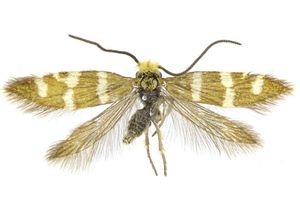

 +1Kontinente:EU
+1Kontinente:EU3. Biologie
3.1. Nahrung der Raupe
Noch unbekannt! Micropterix-Raupen – soweit bekannt – leben von pflanzlichem Detritus am Boden dauerfeuchter Vegetation. Kann es so etwas auf der ausgesprochen trockenen Vulkaninsel Pantelleria überhaupt geben ? Gibt es dort nicht nur anstehendes Lavagestein und ein paar Flecken äußerst trockenheitstoleranter Pflanzen ? Der Autor der Erstbeschreibung der neuen Art stellte sich diese Fragen auch, und er hat einen dringenden Verdacht: Im Umfeld der Fumarolen steigt durchgehend Wasserdampf auf – der Boden dort ist dauerfeucht. Es sollte also der Vulkan selbst sein, der mit dem Rest seiner Aktivität für lokale Dauerfeuchtigkeit und damit ein Larvalhabitat für M. vulcanica sorgt. Spannend.
(Autor: Erwin Rennwald)
4. Weitere Informationen
4.1. Etymologie (Namenserklärung)
Timossi (2025: 125) erläutert seine Namenswahl: „The name of the new species refers to the genesis of the island of Pantelleria caused by a volcanic eruption about 324,000 years ago.” Und da die Art möglicherweise sogar von der Restaktivität des Vulkans abhängig ist, ist das eine besonders gute Namenswahl.
4.2. Taxonomie
Heftige Winde bringen immer wieder einmal Falter von Sizilien oder auch Nordafrika nach Pantelleria. Man muss – wenn man eine neue Art von Pantelleria beschreiben will – also nicht nur die europäische Fauna studieren, sondern auch die nordafrikanische. Der Autor hat beides gründlich getan. Und er hat auch Barcoding mit hinzugezogen um seine morphologischen Befunde auch in einen genetischen Zusammenhang zu stellen. Insofern ist die Beschreibung der neuen Art – zumal sie nicht auf einem Einzelexemplar beruht – sehr gut abgesichert. Timossi (2025: 295-297) erklärt zunächst: „The species phylogenetically closest to M. vulcanica are M. stuebneri known from Spain, and M. isobasella known from the western Alps of Switzerland and Italy. It can be easily distinguished from both by the wing pattern and the male genitalia, which in M. vulcanica have a long uncus, the long tuft of ventral bristles and by the shape of the valves. Furthermore, the habitat is different. Micropterix vulcanica can also be distinguished from the other congeneric species present in Sicily by the wing pattern and the male genitalia. In particular, it can be distinguished from M. uxoria by the tuft of ventral bristles of the uncus and the accessory clasper.“ Und später: “Pantelleria is approximately 70 kilometers from the coast of Tunisia (Cape Bon) whose known Micropterigidae fauna includes two species: Micropterix cartaginensis Heath, 1986 and Micropterix jacobella Walsingham, 1901. These species were studied by Heath in 1986 who was the first to publish their male genitalia and wing pattern. They do not share either the wing pattern or the male genitalia with the new species described here (Heath 1986 fig. 10, 11, 17, 18). Among the known North African species, M. vulcanica resembles Micropterix lambesiella Viette 1949 in terms of male genitalia, with which it shares the tuft of setae ventral to the uncus (Heath 1986 fig. 19, 20). Among the North African species, Micropterix chyaneochrysa Walsingham 1907 described based on a female and a male without abdomen collected in Algeria (Heath 1986 fig. 15) is not adequately represented, and its specific status remains to be verified, but its wing pattern is not that of the new species described here. DNA barcodes are not known for the North African species.” Zum Thema Barcoding ist zu erfahren: „A full DNA barcode sequence 658 bp long was obtained (Lep_1_1631943) from a specimen collected in the same location as the holotype on 13.Iv.2024. The GenBank accession number is Pv891883. […] According to the BOLD Identification Engine, the most similar sequences belong to Micropterix trinacriella at a distance comprised between 3.23% (BOLD sequence page MICoW090-09) and 3.42% (BOLD sequence page BCLEP694-23). However, on the neighbour-joining tree generated by the function “tree based identification”, the first dichotomy separates Micropterix vulcanica sp. nov. from M. isobasella Staudinger, 1871 (distance 3.95%) and M. stuebneri Zeller, Werno & Kurz, 2013 (distance 4.02%).” Ein Barcoding-Abstand zwischen 3 und 4 % ist zwar nicht riesig, aber innerhalb der Gattung normal; zusammen mit den äußeren und genitalmorphologischen Unterschieden ist die Artberechtigung hier aber sehr gut begründet.
4.3. Faunistik
Die neue Art wurde von Pantelleria beschrieben, dort aber an mehreren Stellen der Insel gefunden. Die Frage, ob das jetzt ein Endemit dieser Insel ist, steht damit im Raum. Bei der letzten großen Eruption des Vulkans vor 45.000 Jahren wurde die Insel komplett von neuer Lava überzogen – ein damaliges Überleben eines Falters hier kann ausgeschlossen werden. Die Art müsste also aus zugeflogenen Tieren der weiteren Mittelmeerregion hervorgegangen sein – innerhalb dieses Zeitraums gut möglich. Noch ist aber nicht auszuschließen, dass die Art erst jüngst auf die Insel kam und in der weiteren Mittelmeerregion doch noch weitere Vorkommen hat. Doch bemerkenswert ist dieser Fund auf Pantelleria allemal.
4.4. Typenmaterial
Timossi (2025: 283) stellte zusammen: „Holotype ♂: I, Sicilia, Pantelleria, Montagna Grande 1 609 m slm 36.46'514N 11.59'169E, 13.Iv.2024 nighttime, legit Timossi G.; red label “TYPE Micropterix vulcanica Timossi G. 2025”: MSNG. Paratype: 1♂ I, Sicilia, Pantelleria, Montagna Grande 1 609 m slm 36.46'514N 11.59'169E, 13.IV.2024 d nighttime, legit Timossi G., m. s. 2197 TG: RCTG.; 21 ♂, 2 ♀, idem, RCTG; 2 ♂, idem, DAFFSPa ;2 ♂, 2 ♀, idem, RCMK; 4 ♀ I, Sicilia, Pantelleria, Montagna Grande 2 vetta 812 m slm 36°46'50"N 12°00'19"E, 11.V.2025 daytime, legit Timossi G., RCGT; 3♂ 41♀ I, Sicilia, Pantelleria, Martingana 400 m slm 36.759291N 12.018736 E, 15.III.2024 daytime, legit Ruzzier E., RCER; idem 3 ♂ m. s. 2190, 2191, 2192, 3 ♀ m. s. 2193, 2194, 2195 TG: RCTG; 1♂ I, Sicilia, Pantelleria, Montagna Grande 1 609 m slm 36.46'514N 11.59'169E, 26.II.2025 daytime, legit Lo Verde G.: DAFFSPa . All paratype with red label “PARATYPE Micropetrix vulcanica Timossi G. 2025”.
(Autor: Erwin Rennwald)
4.5. Literatur
- Erstbeschreibung: Timossi, G. (2025): Micropterix vulcanica sp. nov. (Lepidoptera, Micropterigidae) discovered on the island of Pantelleria (Italy, Sicily). — Zootaxa, 5683 (2): 282–288. [zum PDF-Download auf researchgate.net]




